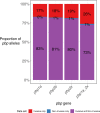Comparison of contemporary invasive and non-invasive Streptococcus pneumoniae isolates reveals new insights into circulating anti-microbial resistance determinants
- PMID: 37823632
- PMCID: PMC10649040
- DOI: 10.1128/aac.00785-23
Comparison of contemporary invasive and non-invasive Streptococcus pneumoniae isolates reveals new insights into circulating anti-microbial resistance determinants
Abstract
Streptococcus pneumoniae is a major human pathogen with a high burden of disease. Non-invasive isolates (those found in non-sterile sites) are thought to be a key source of invasive isolates (those found in sterile sites) and a reservoir of anti-microbial resistance (AMR) determinants. Despite this, pneumococcal surveillance has almost exclusively focused on invasive isolates. We aimed to compare contemporaneous invasive and non-invasive isolate populations to understand how they interact and identify differences in AMR gene distribution. We used a combination of whole-genome sequencing and phenotypic anti-microbial susceptibility testing and a data set of invasive (n = 1,288) and non-invasive (n = 186) pneumococcal isolates, collected in Victoria, Australia, between 2018 and 2022. The non-invasive population had increased levels of antibiotic resistance to multiple classes of antibiotics including beta-lactam antibiotics penicillin and ceftriaxone. We identified genomic intersections between the invasive and non-invasive populations and no distinct phylogenetic clustering of the two populations. However, this analysis revealed sub-populations overrepresented in each population. The sub-populations that had high levels of AMR were overrepresented in the non-invasive population. We determined that WamR-Pneumo was the most accurate in silico tool for predicting resistance to the antibiotics tested. This tool was then used to assess the allelic diversity of the penicillin-binding protein genes, which acquire mutations leading to beta-lactam antibiotic resistance, and found that they were highly conserved (≥80% shared) between the two populations. These findings show the potential of non-invasive isolates to serve as reservoirs of AMR determinants.
Keywords: Streptococcus pneumoniae; antibiotic resistance; genomics.
Conflict of interest statement
The authors declare no conflict of interest.
Figures





Similar articles
-
Population structure, serotype distribution and antibiotic resistance of Streptococcus pneumoniae causing invasive disease in Victoria, Australia.Microb Genom. 2023 Jul;9(7):mgen001070. doi: 10.1099/mgen.0.001070. Microb Genom. 2023. PMID: 37471116 Free PMC article.
-
[Antibiotic resistance analysis of Streptococcus pneumoniae isolates from the hospitalized children in Shanxi Children's Hospital from 2012 to 2014].Zhonghua Er Ke Za Zhi. 2017 Feb 2;55(2):109-114. doi: 10.3760/cma.j.issn.0578-1310.2017.02.011. Zhonghua Er Ke Za Zhi. 2017. PMID: 28173648 Chinese.
-
Using whole genome sequencing to identify resistance determinants and predict antimicrobial resistance phenotypes for year 2015 invasive pneumococcal disease isolates recovered in the United States.Clin Microbiol Infect. 2016 Dec;22(12):1002.e1-1002.e8. doi: 10.1016/j.cmi.2016.08.001. Epub 2016 Aug 17. Clin Microbiol Infect. 2016. PMID: 27542334
-
A twenty years' results of the antimicrobial resistance profile and multidrug resistance trend of invasive Streptococcus pneumoniae isolates recovered from adult patients in Turkey: A literature review.Indian J Med Microbiol. 2022 Jul-Sep;40(3):342-346. doi: 10.1016/j.ijmmb.2022.06.004. Epub 2022 Jul 1. Indian J Med Microbiol. 2022. PMID: 35787332 Review.
-
CIRCULATING CLONAL COMPLEXES AND SEQUENCE TYPES OF STREPTOCOCCUS PNEUMONIAE SEROTYPE 19A WORLDWIDE: THE IMPORTANCE OF MULTIDRUG RESISTANCE: A SYSTEMATIC LITERATURE REVIEW.Expert Rev Vaccines. 2021 Jan;20(1):45-57. doi: 10.1080/14760584.2021.1873136. Epub 2021 Feb 17. Expert Rev Vaccines. 2021. PMID: 33507135
Cited by
-
Non-invasive Streptococcus pneumoniae infections are associated with different serotypes than invasive infections, Belgium, 2020 to 2023.Euro Surveill. 2024 Nov;29(45):2400108. doi: 10.2807/1560-7917.ES.2024.29.45.2400108. Euro Surveill. 2024. PMID: 39512163 Free PMC article.
-
Distribution of serotypes and antibiotic resistance profiles of Streptococcus pneumoniae in hospitalized adult patients: aretrospective multicenter surveillance in China (2018-2019).BMC Infect Dis. 2025 Aug 5;25(1):980. doi: 10.1186/s12879-025-11377-5. BMC Infect Dis. 2025. PMID: 40764912 Free PMC article.
References
-
- Gottlieb T, Collignon PJ, Robson JM, Pearson JC, Bell JM, Australian Group on Antimicrobial Resistance . 2008. Prevalence of antimicrobial resistances in Streptococcus pneumoniae in Australia, 2005: report from the Australian group on antimicrobial resistance. Commun Dis Intell Q Rep 32:242–249. - PubMed
-
- Australian Commission on Safety and Quality in Health Care. AURA 2021 Fourth Australian report on antimicrobial use and resistance in human health [Internet] . 2021. Available from: https://www.safetyandquality.gov.au/our-work/antimicrobial-resistance/an...
Publication types
MeSH terms
Substances
Grants and funding
LinkOut - more resources
Full Text Sources
Medical

